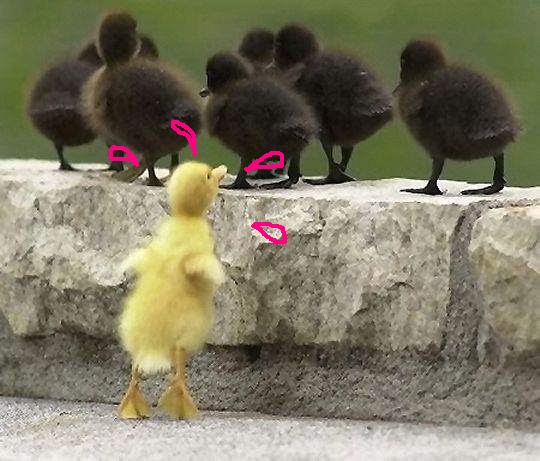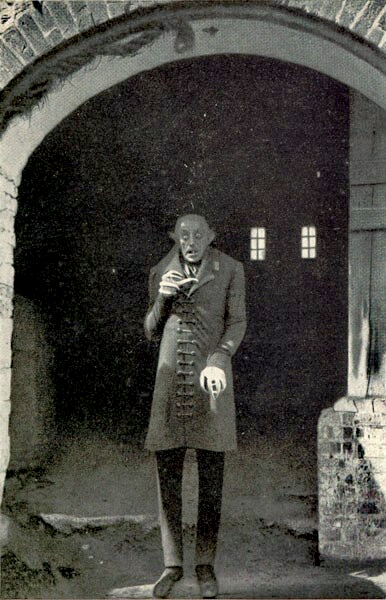After watching Murnau’s “Nosferatu,” I got a sense of what the original Dracula film felt like back in 1922 in the silent, black and white film era. Personally, I found Nosferatu to be more funny than scary but that is probably due to the vast amount of vampire movies we see today. When we see something enough, it becomes less and less frightening because the fear of the unknown no longer exist. I was basically able to anticipate most of the events in the film because this type of movie had become stereotypical today. I’m sure all of us had watched a Dracula movie at some point in our lives, yet very few of us realize where Dracula actually originated.
My favorite character in the movie was definitely Count Orlok. I found it interesting how instead of coming across as a confident and cunning character, he was very secretive and careful about his actions. Also, his appearance was different from what I imagined which was the present-day version of Dracula. I found his appearance to actually be scarier since he had extremely long nails and long bat ears. Also, his fangs are in the middle of his mouth rather than on the side like Dracula’s, which to me, seems scarier and more unnatural, probably because I have been used to picturing vampires with fangs on the sides.


Another interesting character is the psychotic Knock. I believe Knock was much more evil than Orlok himself because Knock administered the whole plan to trick Hutter into visiting Count Orlok’s castle and selling the house across the street to him. He looks just about as scary as Orlok does as well with his extremely thick eyebrows and crazy hair.

I was surprised by Hutter’s ignorance throughout the movie despite all the warnings he received from the people around him. He seemed to have no clue that Orlok was Nosferatu until he actually saw him with his eyes getting ready to suck his blood. Even after Orlok attempted to suck the blood off a cut in his hand, he still did not suspect anything and attributed the marks on his neck to bugs. I found this part of the film to be humorous.
The only scene that was able to frighten me a bit was the scene in the ship when Orlok stiffly rises from his coffin. Right after that scene, I was shocked by the captain’s decision to submit himself to Orlok rather than jumping off the ship like his first mate did. Honestly, if I were in his situation, I would rather die by drowning into the ocean than get the blood sucked out of me by a vampire. Also, at the end of the movie, I was very surprised by Nina’s decision to sacrifice herself to Orlok in order to save everyone in Bremen. I am confused about the ending though because I am not sure if Nina actually died or not.
An aspect of the movie I really liked was Murnau’s building of suspense. Throughout the entire movie, Murnau used simple sounds, music, images, and expressions to trigger a sense of doom. When I realized this film had text instead of voices, I was perplexed at how this movie can possibly be scary and Murnau did a really good job at showing us how a movie with text could be just as good as a movie with voice. Obviously, Murnau had to make emotions much more extreme than they would be in real life in order to get the feeling of fear across. Murnau also used animals and nature as symbols to convey doom by showing horses running away and the sky darkening.

Murnau’s use of the vampire book for Hutter and Nina to discover the secrets of Nosferatu was also a really good way to cope with the lack of voice. Since the characters couldn’t speak, they couldn’t tell each other information through word of mouth so the only way he could show the communication of knowledge was through fine print inscribed in a book.
I was also surprised by Marnau’s montages since I was unaware that the montage technique was used in filmmaking during the 1920s. I think it was very effective because it conveys how Hutter’s escape by land, Orlok’s journey by sea, and Nina’s restless worrying were simultaneous. Also, Marnau did incorporate special effects such as the speed up in the movement of Orlok’s servant and the vanishment of Orlok at the end of the film.
Overall, I think Nosferatu was extremely creative for its time and presented many new ideas that would later be replicated by a plethora of Dracula films. Although it was nowhere near as scary as even a poorly made horror film today, we have to give it credit for being the pioneer of vampire films and we have to take into account the limitations of technology back in the 1920s.

A Collage containing most of the present-day films inspired by “Nosferatu”
PS: I just wanted to point out that the text stayed on the screen of the film extremely long. In some cases, I was able to read the text 6-8 times before it disappeared and I will admit that I got a bit frustrated with the long lapse of time the text was on the screen. I’m not really sure if Murnau had any intentions in doing this or if people’s reading speed was slower in the 1920s.
Picture Citations:
Create a Monster Collage to Decorate Your Home. Digital image. Squidoo. Squidoo, LLC, 2013. Web. 28 Oct. 2013.
Francavilla, Francesco. The Vampire Book. Digital image. The Art of Francesco Francavilla. Francesco Francavilla, 13 Oct. 2009. Web. 28 Oct. 2013.
White, Derek. The Language of Nosferatu. Digital image. Clusterflock. N.p., 29 Mar. 2010. Web. 28 Oct. 2013.
Greene, R, H,. Dracula. Digital image. INCARNADINE: The True Memoirs of Count Dracula. Dracula Memoirs, n.d. Web. 28 Oct. 2013.
























